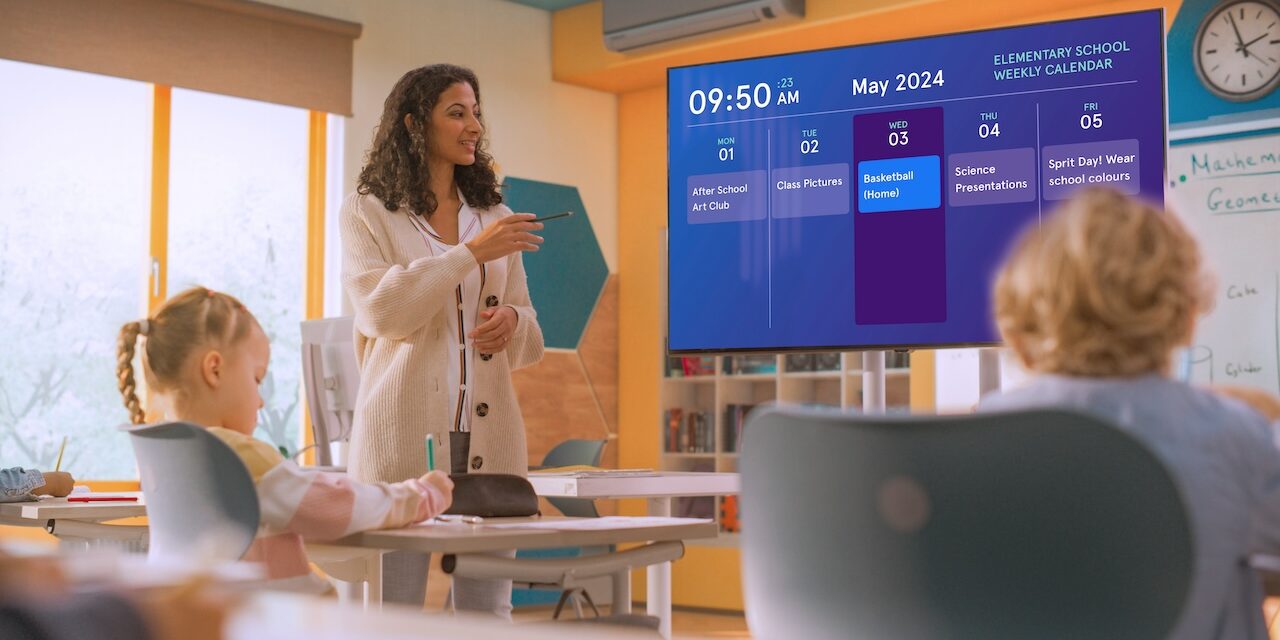The Ultimate Guide to rolling out Digital Signage and Wireless Screen Sharing for MATs
In today’s rapidly evolving educational landscape, technology is not just a tool but a bridge to deeper student engagement and real-world preparedness. For Multi Academy Trusts (MATs), implementing digital signage and wireless screen sharing creates immersive learning environments where students interact with the kind of technology they will encounter in higher education and their future careers. These solutions enhance communication, collaboration, and overall classroom experiences, ensuring that education remains dynamic, interactive, and relevant to the digital age.
This guide is designed to help IT professionals within MATs seamlessly plan, deploy, and scale these solutions while ensuring minimal disruption and maximum impact. Throughout, we’ll highlight how Vivi’s solutions can simplify and enhance this process.
Planning Your Rollout Strategy

Rolling out new technology across a MAT involves careful planning to ensure smooth implementation, minimal disruption, and long-term sustainability. A successful strategy will consider your existing infrastructure, engage the right stakeholders, and align with your educational goals. Below, we break down the key steps for planning your rollout.
1. Assessing Current Infrastructure Across Academies and Schools
Before introducing new technologies, it’s critical to understand your current IT landscape. This assessment ensures that your infrastructure can support the new tools and identifies any areas for improvement. Consider the following:
- Network capabilities: Conduct an in-depth review of your network’s bandwidth and capacity across schools and academies. Are your Wi-Fi networks robust enough to support the increased traffic from wireless screen sharing and digital signage systems? You may need to upgrade routers, switches, or even your broadband connection to ensure seamless usage across multiple locations.
- Existing hardware: Take stock of your current devices and screens. Can existing displays be repurposed for digital signage? Are there enough devices to support wireless screen sharing in classrooms? This can help you avoid unnecessary purchases, allowing you to repurpose or upgrade existing equipment instead.
- AV systems and integration: Evaluate current AV setups in classrooms and public areas. Are there any integration issues that might hinder the new technology? For example, while older projectors or smartboards might initially seem incompatible with wireless sharing solutions, Vivi ensures that even these devices can be seamlessly integrated into your classroom environment. Vivi works across a wide range of displays, enabling you to use existing AV equipment without the need for costly upgrades.
Action Tip: Create a detailed infrastructure assessment report, identifying areas where upgrades or additional resources are needed. This will form the foundation of your rollout plan.
2. Identifying Key Stakeholders
Involving the right stakeholders early in the process is essential to a smooth rollout. Collaboration across departments ensures that all needs and challenges are considered and addressed. Key stakeholders to involve include:
- IT teams: The backbone of your rollout, the IT team will ensure the technology integrates seamlessly with your existing systems, troubleshoot any technical issues, and provide ongoing support. They will also be crucial in managing the security and privacy concerns associated with wireless screen sharing and digital signage.
- School leadership: MAT leadership must be aligned with the vision for the technology rollout. They will play a key role in securing funding, ensuring alignment with educational goals, and providing the leadership needed to drive the initiative across multiple academies.
- Teachers and staff: Teachers will be the primary users of wireless screen sharing, so it’s essential to involve them early to understand their needs and expectations. This ensures that the technology supports their teaching methods and enhances the student learning experience. Teachers can also help in testing the technology and providing valuable feedback during the pilot phase.
In addition to teaching staff, catering and office staff could be primary users of digital signage. Catering staff can use it to display lunch menus, special dietary information, or daily specials, creating a more engaging and dynamic dining experience for students. Office staff can leverage digital signage for school announcements, event reminders, or emergency alerts, ensuring everyone stays informed in real time. Involve these teams in the planning and testing phases to ensure that digital signage meets their specific needs and fits seamlessly into their workflows.
- Students and parents: While not directly involved in the deployment, engaging students and parents helps to ensure buy-in and smooth adoption. For instance, students can provide feedback on how easy they find the wireless screen sharing, and parents may appreciate digital signage to stay informed about school events and achievements.
Action Tip: Set up a series of meetings or workshops to get input from all stakeholders. Consider creating a working group or steering committee to guide the process and address concerns as they arise.
3. Define Objectives and Success Metrics
Establishing clear goals is key to measuring the success of your rollout and aligning the initiative with your wider educational objectives. Consider the following objectives:
- Enhanced communication: One of the core benefits of digital signage is its ability to improve communication across campuses. Aim to achieve a set level of content delivery through digital signage (e.g., 80% of schools displaying real-time updates within three months).
- Improved classroom engagement: Wireless screen sharing should make collaboration more seamless and increase student engagement. Set specific engagement targets, such as increasing collaborative projects or classroom participation rates.
- Operational efficiency: Reduce reliance on paper-based communication and streamline content management through a centralised dashboard. Success could be measured by a reduction in printing costs or administrative time spent updating noticeboards.
- Professional development for teachers: One objective should be to ensure that staff feel confident and capable using the new technology. Success criteria could include a percentage of teachers completing training or using wireless screen sharing during lessons.
Action Tip: Work with stakeholders to define SMART (Specific, Measurable, Achievable, Relevant, Time-bound) objectives and success metrics. This provides clarity and helps you track progress.
4. Budgeting for Implementation and Long-term Sustainability
Effective budgeting ensures that the technology rollout is financially viable and sustainable in the long term. Key considerations include:
- Initial setup costs: Budget for hardware (e.g., screens, wireless adapters), software (e.g., digital signage platforms), and any necessary infrastructure upgrades (e.g., network enhancements). Don't forget costs for professional services like installation and training.
- Ongoing costs: Consider the recurring costs of licensing for software, subscription fees for cloud-based platforms, and any long-term hardware maintenance or upgrades. Ensure that you have a plan to manage these ongoing costs, particularly as technology evolves.
- Funding sources: Explore various funding options, including internal budgets, external grants, and possible government funding schemes. In the UK, for instance, there are often government initiatives designed to help schools implement EdTech solutions. Look into Department for Education (DfE) funding, local authority budgets, or specific EdTech Innovation Fund programs that could offset costs.
- Cost-sharing models across schools: If you are deploying across multiple schools or campuses, consider whether bulk buying or pooling resources across the MAT could reduce costs. Additionally, investigate the possibility of using existing hardware for digital signage displays, such as reusing classroom TVs or projectors where appropriate. Another strategy to reduce costs is to find a supplier, such as Vivi, that offers multiple solutions within a single subscription package. By bundling services like emergency alerts, digital signage, and wireless screen sharing into one comprehensive package, you can often access all the technology you need for a fraction of the cost. This model not only simplifies billing and management but also enables schools to leverage a range of tools without needing separate budgets for each solution. Combining these solutions can provide significant cost savings while delivering a broader range of benefits across the entire MAT.
- Long-term sustainability: It’s important to account for the ongoing maintenance and upgrading of systems. Set aside a budget for routine software updates, system troubleshooting, and potential future hardware replacements. Consider implementing a technology refresh cycle to ensure that devices and systems are always current and functioning optimally.
Action Tip: Create a detailed budget that spans both the initial implementation phase and ongoing support. This will help you plan for the total cost of ownership and avoid unexpected expenses. Look for external funding opportunities or internal savings that could help cover costs.
5. Plan for Minimal Disruption
A critical part of any successful rollout is ensuring that technology adoption does not interfere with day-to-day teaching and learning activities. To achieve this, it’s important to adopt a gradual and phased approach. By implementing technology in stages, you can ensure that each academy and department is supported throughout the transition, allowing teachers and students time to adapt without feeling overwhelmed. Testing and piloting the technology with small groups or specific departments first will help you identify any challenges before scaling across the whole trust. This approach also helps to reduce the risk of technical issues affecting critical learning activities.
Action Tip: Consider dividing your rollout into phases, starting with a pilot group and gradually expanding to other schools. This way, you can ensure smooth adoption with minimal disruption to classroom activities.
Rolling out digital signage and wireless screen sharing across your MAT requires careful planning, collaboration, and execution. By assessing your current infrastructure, identifying the right stakeholders, setting clear objectives, budgeting effectively, and planning for minimal disruption, you can ensure that the rollout is successful and sustainable.
Step-by-Step Deployment Guide

Phase 1: Preparation & Assessment
The first phase of deployment is focused on preparing the infrastructure and gathering insights from key stakeholders. This phase ensures that all technical and practical requirements are met before moving forward.
- Conduct IT infrastructure analysis
Before introducing any new technology, it’s vital to assess the current infrastructure to ensure it can support the new systems. This includes evaluating bandwidth and Wi-Fi strength across all campuses. Are there any network limitations that could impact the performance of wireless screen sharing or digital signage? Inadequate bandwidth or poor Wi-Fi coverage could hinder the user experience, so it’s important to identify any weaknesses early and address them.
Additionally, consider the device compatibility of existing hardware with the new systems. For instance, older devices may need an upgrade or additional configuration to support the wireless screen sharing system.
- Identify optimal locations for digital signage screens and wireless screen sharing access points
Choosing the right locations for both digital signage displays and wireless screen sharing access points is crucial to maximising the effectiveness of the deployment. Digital signage should be strategically placed in high-traffic areas like school corridors, dining areas, and assembly halls. For wireless screen sharing, ensure that access points are placed in classrooms where the technology will be most used, taking into account the size and layout of the rooms.
Action Tip: Create a map of your academies to plan out where digital signage displays and access points will be installed for maximum visibility and accessibility.
- Engage stakeholders to gather input and ensure alignment with school needs
Engage with key stakeholders, including teachers, school leadership, IT teams, and office/catering staff, to gather input and ensure the deployment meets the unique needs of each academy. Understanding their pain points, preferences, and expectations will help you design a more effective rollout strategy.
Action Tip: Hold workshops or meetings to collect feedback from these groups and identify potential challenges before the installation phase begins.
Phase 2: Selecting the Right Technology
In this phase, the focus is on selecting the right technology to ensure your digital signage and wireless screen sharing systems are easy to manage, scalable, and aligned with your MAT’s goals.
- Why Vivi for digital signage?
Vivi offers a cloud-based, scalable, and easy-to-manage digital signage solution that makes it simple for schools to share real-time information, event updates, and student achievements. The platform is user-friendly and can be managed centrally, which is ideal for MATs with multiple academies. Vivi’s system ensures that updates are uniform across all locations, eliminating the need for individual school administrators to manually manage content.
Vivi’s solution also allows schools to repurpose existing hardware, such as classroom TVs or projectors, reducing costs associated with new equipment purchases.
- Why Vivi for wireless screen sharing?
Vivi’s wireless screen sharing solution is device-agnostic, meaning it works with a wide range of devices, from laptops to tablets to smartphones. It’s a secure, teacher-controlled platform that enables seamless collaboration between students and teachers. By eliminating cables and complex setups, Vivi ensures a smooth and time-efficient classroom experience, improving engagement and encouraging interactive learning.
As mentioned above, Vivi is also display-agnostic, allowing you to integrate both new and older displays seamlessly. Schools can pair modern 4K interactive flat panels (such as Clevertouch, Promethean, or SMART displays) with existing legacy projectors (such as Epson EB series, BenQ MW series, or older Promethean ActivBoards). This flexibility ensures that MATs can maximise existing AV investments while still upgrading their classroom technology for the future.
Action Tip: Ensure that all schools are aware of Vivi’s flexible, secure solutions that can be scaled to meet both current and future needs.
- Ensure hardware and software compatibility across all academies
Once you’ve chosen Vivi’s solutions, ensure that all schools within your MAT have the necessary hardware (displays, access points, etc.) and software (cloud platforms, management tools) to support the system. Check for any potential compatibility issues between your existing IT infrastructure and Vivi’s platform. For example, are the schools’ Wi-Fi networks robust enough to support the wireless screen sharing features?
Action Tip: Set up a compatibility test at each school to verify that the new technology will integrate smoothly with the current infrastructure.
Phase 3: Installation and Setup
This is where the deployment becomes hands-on. Installation and setup are critical to ensuring that everything works as expected and there are no surprises during the launch phase.
- Deploy Vivi digital signage displays across campuses
Begin with installing the digital signage displays in the pre-identified locations. Ensure that each display is connected to the network and configured to receive content from the central management system. Test each screen to ensure that it displays the correct content in real time.
- Configure Vivi wireless screen sharing in classrooms
Set up and test the wireless screen sharing access points in classrooms. Each access point should be configured to allow seamless connectivity for all types of devices used by teachers and students. Ensure that teachers have control over the content being shared and that the system is secure and easy to operate.
- Set up permissions, access controls, and centralised management
To streamline operations and ensure security, configure permissions and access controls within the management platform. This includes determining who has the authority to update content on the digital signage displays or access and control wireless screen sharing in classrooms. A centralised management system will allow administrators to easily control and monitor usage across all schools within the MAT.
- Test and troubleshoot to ensure seamless operation
Thoroughly test both the digital signage and wireless screen sharing systems to ensure they are functioning smoothly. Address any technical issues, such as connectivity problems or hardware malfunctions, before the systems go live. Troubleshooting is an essential part of the installation process to ensure that all systems are operational and reliable.
Phase 4: Training and Adoption
Once everything is installed, the focus shifts to training and adoption. Ensuring that teachers, staff, and IT teams are well-prepared to use the new systems will be key to their success.
- Conduct pilot programmes in select schools before full deployment
Before launching the technology across all schools, start with a pilot programme in a small group of schools or classrooms. This will allow you to test the systems in real-life settings and gather valuable feedback from users. It also provides an opportunity to identify any challenges or issues that can be addressed before a wider rollout.
- Provide structured training for teachers, staff, and IT teams
Offer structured training sessions for teachers, office and catering staff, and IT teams. This should include how to use the wireless screen sharing system in the classroom, how to manage and update digital signage, and how to troubleshoot common issues. Make sure to cover all user types and needs so that everyone feels confident in using the technology.
- Develop easy-to-follow user guides and support materials
To complement the training sessions, create user guides and support materials that are easy to follow. These resources should include step-by-step instructions on how to use the technology, troubleshoot common issues, and get help when needed. Ensure these materials are accessible both in digital and print formats.
- Encourage adoption through hands-on demonstrations and feedback loops
Organise hands-on demonstrations and training workshops to encourage adoption. Allow staff to get familiar with the technology and provide feedback throughout the process. Their input will help fine-tune the system and identify any areas for improvement. Create a feedback loop that allows ongoing adjustments based on user experiences.
Phase 5: Scaling Across the Trust
After successful implementation in pilot schools, it’s time to expand and scale the deployment across the entire MAT.
- Collect feedback from initial deployments and refine strategies
After the initial deployment, gather feedback from teachers, staff, and students about the effectiveness of the new systems. Identify any challenges or successes to refine your deployment strategies for future schools.
- Expand rollout based on tested success models
Use the lessons learned from the pilot phase to guide the expansion to other schools. This will help ensure a smooth and successful deployment across the entire trust. Consider adopting best practices identified during the pilot phase to streamline the process.
- Standardise best practices for content management and device usage
Create standardised procedures for managing content on digital signage displays and for using wireless screen sharing in classrooms. This will ensure consistency across all academies, making it easier for staff and IT teams to manage the technology.
- Monitor success through engagement metrics and IT support reduction
Continuously monitor the success of your deployment by tracking engagement metrics such as the frequency of digital signage updates, wireless screen sharing usage in classrooms, and user feedback. Additionally, measure any reductions in IT support requests, as a successful deployment should lead to fewer technical issues and less frequent troubleshooting.
By following this step-by-step deployment guide, your MAT will be well on its way to successfully rolling out Vivi’s digital signage and wireless screen sharing solutions, creating a connected, efficient, and engaging learning environment for students and staff across all schools.
Overcoming Common Challenges

Rolling out digital signage and wireless screen sharing across a MAT presents several challenges, but with the right approach, these can be effectively managed. One of the most common concerns is bandwidth and security. A reliable network is essential for smooth screen sharing and real-time digital signage updates. To prevent disruptions, MATs should optimise network settings, prioritise traffic for these solutions, and ensure strong WiFi coverage across classrooms and communal areas. Security must also be a priority, with measures such as encrypted connections, user authentication, and network segmentation helping to protect data and prevent unauthorised access. Vivi’s cloud-based platform ensures encrypted, teacher-controlled screen sharing without overloading the network, making it a secure and efficient solution.
Another challenge is content consistency across multiple schools. A cloud-based content management system like Vivi allows centralised control and scheduling, ensuring a cohesive look while enabling schools to display relevant announcements. Vivi simplifies this with pre-designed templates for professional signage and integration with content providers like ClickView, making it easy to showcase educational videos and dynamic content. A strong content strategy, incorporating updates, achievements, event reminders, and emergency alerts, keeps school communities informed and engaged while maintaining a professional and unified digital signage experience.
Encouraging user adoption is also crucial for success. Teachers, staff, and students must feel comfortable using the technology, so structured onboarding and hands-on training should be provided. Accessible user guides and video tutorials can support self-paced learning, while regular demonstrations can showcase how wireless screen sharing enhances lesson delivery and student engagement. Creating a feedback loop where staff can share their experiences and suggest improvements helps refine the implementation process and fosters a sense of ownership over the technology.
Finally, ongoing maintenance is key to sustaining the long-term benefits of digital signage and wireless screen sharing. Regular system checks can help identify potential technical issues before they impact users, while clear IT support channels ensure that staff know where to seek assistance if problems arise. Keeping software and firmware up to date enhances security and performance, and ongoing monitoring of system performance and user feedback allows for continuous improvements.
By proactively addressing these challenges, MATs can ensure a smooth, sustainable, and impactful implementation of digital signage and wireless screen sharing, ultimately creating a more connected and technologically enriched learning environment.
Real-World Success Stories
Rolling out new technology across a MAT can feel like a challenge, but schools using Vivi are seeing real, tangible improvements in classroom engagement, IT efficiency, and communication. From seamless wireless screen sharing to engaging digital signage, MATs across the UK and beyond are creating smarter, more connected learning environments.
For many educators, unreliable technology has long been an unfortunate reality with teachers often developing contingency plans for broken or lost cables, sluggish computers, and outdated equipment. However, the right tools can change that experience entirely. As one teacher from Mountain View Los Altos High School District put it:
"For the first time in my career, I don’t feel like I have to just ‘make do’ with inadequate technology. It’s exciting to work in a place where the tech just works. I feel efficient, I feel like I’m teaching students to have strong relationships with technology, and I truly appreciate those who made it happen."
At Nova Education Trust, Vivi’s centralised digital signage solution helped create a stronger sense of community across multiple schools. Their IT team found Vivi to be the perfect fit for easy, cloud-based content management, ensuring consistency across campuses while allowing individual schools to highlight their own messaging. Vivi’s ability to support instant communication, from routine updates to urgent alerts, proved invaluable. As Nova’s IT team noted, Vivi provides a reliable, scalable, and intuitive solution that works for both educators and administrators.
The impact of seamless, intuitive technology goes beyond convenience as it transforms decision-making at the highest levels. As Austen Puleston from Birmingham Diocesan Multi-Academy Trust put it:
"When technology becomes a true aid for efficient and effective teaching and learning, budget discussions no longer revolve around cost, instead they focus on value. That’s when real progress happens."
Similarly, at Dartford Grammar School for Girls, Vivi’s digital signage made an immediate impact. Dan Elvy, a key IT leader, highlighted its visual appeal:
"I’m very impressed with how sleek and professional it all looks on screen."
Beyond just wireless screen sharing, Vivi’s all-in-one solution for digital signage, emergency alerts, and student engagement tools sets it apart. Graham Wooten of Elstree School noted:
"There are lots of companies out there doing screen sharing. What makes Vivi special is all the other things it can do!"
With Vivi’s intuitive, device-agnostic platform, MATs are improving communication, reducing IT workload, and creating modern, interactive learning environments. Schools that have implemented Vivi report faster lesson transitions, improved engagement, and more efficient IT management, leading to a more connected and future-ready education experience across their Trusts.
Conclusion and Next Steps

Rolling out digital signage and wireless screen sharing across your MAT is more than just a technology upgrade, it’s an opportunity to enhance communication, improve engagement, and create seamless learning environments. By following a structured approach, from assessing your current infrastructure to selecting the right solutions, deploying strategically, and ensuring user adoption, your MAT can maximise impact while minimising disruption.
With Vivi’s all-in-one platform, IT managers can implement scalable, secure, and easy-to-manage solutions that benefit students, teachers, and school leaders alike. Whether its wireless screen sharing that just works, engaging digital signage, or emergency alerts for real-time communication, Vivi ensures that technology becomes an aid, not a barrier, to effective teaching and learning.
Actionable Checklist for IT Managers
- Assess your infrastructure: conduct a network and AV audit to ensure readiness.
- Engage key stakeholders: gather input from leadership, IT teams, and teaching staff.
- Define success metrics: set clear objectives for engagement, efficiency, and cost savings.
- Select the right technology: choose scalable, device-agnostic solutions that integrate with existing systems.
- Plan your deployment: use a phased rollout strategy to minimise disruption.
- Support adoption: provide training and ongoing IT support to ensure smooth implementation.
- Measure and scale: track engagement and IT efficiencies, then expand rollout based on insights.
Get started with Vivi
The best way to see how Vivi can transform your MAT is to try it for yourself. Vivi offers:
A Free Demo: Experience Vivi’s features in action.
A Consultation: Work with our team to tailor a rollout strategy for your MAT.
A Trial: Deploy Vivi in select classrooms and schools before full implementation.
Additional Resources and Ongoing Support
Explore case studies from other MATs that have successfully implemented Vivi
Access training videos, user guides, and best-practice playbooks.
Contact our dedicated account manager for expert guidance every step of the way.
With the right plan and the right tools, your MAT can create a more connected, interactive, and future-ready learning environment. Let’s make it happen together.
